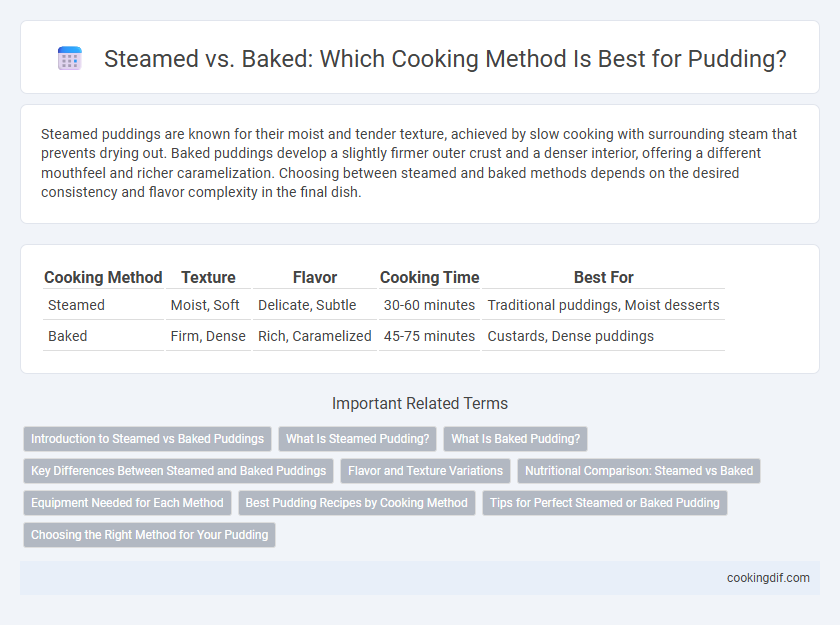Steamed puddings are known for their moist and tender texture, achieved by slow cooking with surrounding steam that prevents drying out. Baked puddings develop a slightly firmer outer crust and a denser interior, offering a different mouthfeel and richer caramelization. Choosing between steamed and baked methods depends on the desired consistency and flavor complexity in the final dish.
Table of Comparison
| Cooking Method | Texture | Flavor | Cooking Time | Best For |
|---|---|---|---|---|
| Steamed | Moist, Soft | Delicate, Subtle | 30-60 minutes | Traditional puddings, Moist desserts |
| Baked | Firm, Dense | Rich, Caramelized | 45-75 minutes | Custards, Dense puddings |
Introduction to Steamed vs Baked Puddings
Steamed puddings retain moisture through gentle, even heat, resulting in a dense, moist texture ideal for traditional British desserts like sticky toffee pudding. Baked puddings cook by dry heat, creating a firmer crust and lighter interior, commonly seen in classic American bread puddings. Understanding these methods highlights how steaming preserves softness while baking enhances structure and caramelization.
What Is Steamed Pudding?
Steamed pudding is a traditional British dessert characterized by its moist, dense texture achieved through slow cooking in a steam environment. This method involves placing the batter in a sealed mold or cloth and cooking it over boiling water, which preserves moisture and ensures even heat distribution. Unlike baked puddings, steamed puddings develop a richer, softer consistency with a deep, complex flavor profile due to the gentle cooking process.
What Is Baked Pudding?
Baked pudding is a traditional dessert cooked in the oven, where the batter or mixture solidifies slowly, developing a golden crust and dense texture. Unlike steamed pudding, which retains moisture through steam, baked pudding forms a firm outer layer while maintaining a soft interior. Popular varieties include bread pudding and Yorkshire pudding, both showcasing the rich, caramelized flavors achieved through baking.
Key Differences Between Steamed and Baked Puddings
Steamed puddings are cooked using moist heat, resulting in a soft, dense texture with increased moisture retention, while baked puddings are exposed to dry heat, creating a firmer crust and a more structured interior. Steaming preserves delicate flavors and prevents drying out, making it ideal for traditional British puddings like Christmas pudding, whereas baking enhances caramelization and browning, suited for bread pudding and custard-based desserts. Cooking times also differ, with steaming generally requiring longer periods at lower temperatures compared to faster, higher-temperature baking methods.
Flavor and Texture Variations
Steamed pudding offers a moist, tender texture with a delicate, subtly infused flavor due to gentle, even cooking. Baked pudding develops a denser, richer texture with caramelized edges, enhancing depth and complexity in taste. Choosing between steaming and baking significantly impacts the pudding's mouthfeel and flavor intensity.
Nutritional Comparison: Steamed vs Baked
Steamed pudding retains more moisture and nutrients such as vitamin C and B vitamins due to the lower cooking temperature and reduced oxidation. Baked pudding often has a denser texture with slightly higher calorie content as some water evaporates, concentrating sugars and fats. Both methods preserve protein and fiber content, but steaming is generally preferred for maintaining vitamin integrity and lower fat oxidation.
Equipment Needed for Each Method
Steamed pudding requires a setup that includes a heatproof bowl or mold, a large pot or steamer with a lid, and a rack or trivet to keep the pudding above boiling water, ensuring gentle, moist cooking. Baked pudding demands an oven-safe dish and often a water bath (bain-marie) to regulate temperature and prevent drying, plus an oven preheated to the required temperature. Both methods necessitate specific equipment to maintain consistent heat and achieve the desired texture in the final pudding.
Best Pudding Recipes by Cooking Method
Steamed puddings retain moisture and yield a dense, soft texture, making them ideal for traditional suet or fruit-based recipes like Christmas pudding. Baked puddings develop a golden crust and offer a firmer structure, perfect for bread pudding or custard-style desserts. Choosing the cooking method depends on the desired consistency and flavor intensity in the best pudding recipes.
Tips for Perfect Steamed or Baked Pudding
Steamed puddings retain moisture by cooking in a sealed environment, so ensure the pudding basin is tightly covered with foil to prevent water from entering. Baked puddings develop a firmer texture and golden crust, making it essential to use a water bath for even heat distribution and avoid overbaking. For both methods, allow the pudding to rest before serving to enhance flavors and achieve the perfect consistency.
Choosing the Right Method for Your Pudding
Steamed puddings retain moisture and produce a dense, velvety texture ideal for traditional British desserts like Christmas pudding and treacle pudding. Baked puddings develop a firmer crust and a lighter interior, perfect for fruit crumbles and bread puddings that benefit from a crisp top layer. Selecting the cooking method depends on the desired texture and flavor intensity, with steaming enhancing richness and baking adding subtle caramelization.
Steamed vs Baked for cooking method Infographic

 cookingdif.com
cookingdif.com